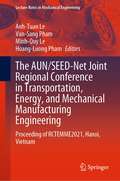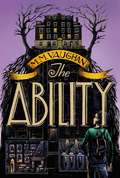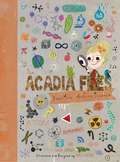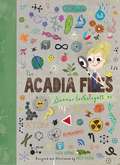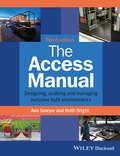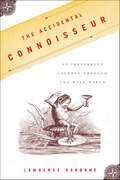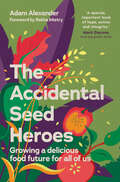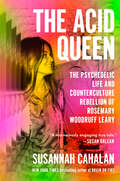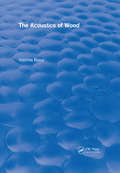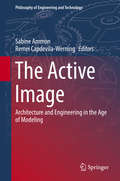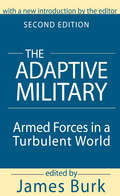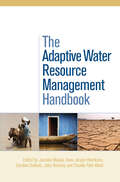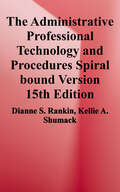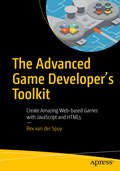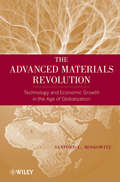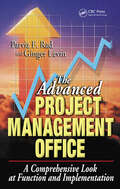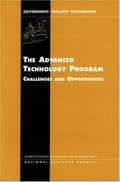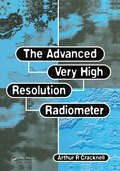- Table View
- List View
The ARRL Ham Radio License Manual (1st edition)
by Ward SilverThe most popular introduction to amateur radio, this guide offers a unique mix of technology, public service, convenience, and fun. All levels of ham radio operators can brush up on their skills and use the book to study for their first license exam with the latest questions pool with answer key.
The ARRL Ham Radio License Manual (2nd edition)
by Ward SilverThe ARRL Ham Radio License Manual is your ticket to joining the ranks of amateur radio operators. Use this book to discover the appeal of ham radio.
The AUN/SEED-Net Joint Regional Conference in Transportation, Energy, and Mechanical Manufacturing Engineering: Proceeding of RCTEMME2021, Hanoi, Vietnam (Lecture Notes in Mechanical Engineering)
by Anh-Tuan Le Van-Sang Pham Minh-Quy Le Hoang-Luong PhamThis book (The AUN/SEED-Net Joint Regional Conference in Transportation, Energy, and Mechanical Manufacturing Engineering) gathers selected papers submitted to the 14th Regional Conference in Energy Engineering and the 13th Regional Conference in Mechanical Manufacturing Engineering in the fields related to intelligent equipment, automotive engineering, mechanical systems and sustainable manufacturing, renewable energy, heat and mass transfer. Under the theme of “Integration and Innovation for Sustainable Development,” This book consists of papers in the aforementioned fields presented by researchers and scientists from universities, research institutes, and industry showcasing their latest findings and discussions with an emphasis on innovations and developments in embracing the new norm, resulting from the COVID-19 pandemic.
The Ability
by Iacopo Bruno M. M. VaughanDelve into the extraordinary abilities of the twelve-year-old mind in this "fast-paced, superhero-tinged spy novel" (Publishers Weekly), the thrilling start to a middle grade series that expands the possibilities of power.No one has any confidence in twelve-year-old Christopher Lane. His teachers discount him as a liar and a thief, and his mom doesn't have the energy to deal with him. But a mysterious visit from the Ministry of Education indicates that Chris might have some potential after all: He is invited to attend the prestigious Myers Holt Academy. When Christopher begins at his new school, he is astounded at what he can do. It seems that age twelve is a special time for the human brain, which is capable of remarkable feats--as also evidenced by Chris's peers Ernest and Mortimer Genver, who, at the direction of their vengeful and manipulative mother, are testing the boundaries of the human mind. But all this experimentation has consequences, and Chris soon finds himself forced to face them--or his new life will be over before it can begin.
The Ability
by Iacopo Bruno M. M. VaughanDelve into the extraordinary abilities of the twelve-year-old mind in this thrilling start to a middle-grade series that expands the possibilities of power.No one has any confidence in twelve-year-old Christopher Lane. His teachers discount him as a liar and a thief, and his mom doesn't have the energy to deal with him. But a mysterious visit from the Ministry of Education indicates that Chris might have some potential after all: He is invited to attend the prestigious Myers Holt Academy. When Christopher begins at his new school, he is astounded at what he can do. It seems that age twelve is a special time for the human brain, which is capable of remarkable feats--as also evidenced by Chris's peers Ernest and Mortimer Genver, who, at the direction of their vengeful and manipulative mother, are testing the boundaries of the human mind. But all this experimentation has consequences, and Chris soon finds himself forced to face them--or his new life will be over before it can begin.
The Abundant University: Remaking Higher Education for a Digital World
by Michael D. SmithWhy our current system of higher education is financially and morally unsustainable and how to address the crisis with the creative implementation of digital technologies.For too long, our system of higher education has been defined by scarcity: scarcity in enrollment, scarcity in instruction, and scarcity in credentials. In addition to failing students professionally, this system has exacerbated social injustice and socioeconomic stratification across the globe. In The Abundant University, Michael D. Smith argues that the only way to create a financially and morally sustainable higher education system is by embracing digital technologies for enrolling, instructing, and credentialing students—the same technologies that we have seen create abundance in access to resources in industry after industry.The Abundant University explains how we got our current system, why it&’s such an expensive, inefficient mess, and how a system based on exclusivity cannot foster inclusivity. Smith challenges the resistance to digital technologies that we have already seen among numerous institutions, citing the examples of faculty resistance toward digital learning platforms. While acknowledging the understandable self-preservation instinct of our current system of residential education, Smith makes a case for how technology can engender greater educational opportunity and create changes that will benefit students, employers, and society as a whole.
The Acadia Files: Book Two, Autumn Science (The\acadia Files Ser. #1)
by Katie Coppens Holly HatamBooks that explore science through adventure The Acadia Files: Book Two, Autumn Science presents five stories of fall, each one followed by Acadia’s science notebook pages with her simple explanations and lively, whimsical drawings of natural phenomena. The Acadia Files is a fun introduction to the wonders of science, using real-world scenarios to make scientific inquiry relatable and understandable. Parents and educators can use The Acadia Files to let kids discover for themselves what it’s like to be curious about the world and to satisfy that curiosity with scientific thinking. Acadia Greene wants answers. What happened to the frogs she used to see at her favorite local pond? Why do leaves change color in the fall, and why don’t evergreen needles do the same? What is the water cycle, and what is transpiration? How do time zones work, and why does the sun set at different times in different places within a single zone? How do germs infect us? Acadia doesn’t mean to do science, but she has questions and her parents refuse to simply give her the answers. “Conduct an experiment,” they tell her. “Use the scientific method.” So Acadia makes hypotheses, designs experiments, analyzes data, and draws conclusions. Acadia does science. The author, Katie Coppens writes a recurring column for NSTA's middle school magazine Science Scope on science and literacy called "The Integrated Classroom."
The Acadia Files: The Summer Investigations (The Acadia Files #1)
by Katie Coppens Holly HatamThe Acadia Files: Summer Investigations presents five summer stories, each one followed by Acadia’s science notebook pages with her simple explanations and lively, whimsical drawings of natural phenomena. The Acadia Files is a fun introduction to the wonders of science, using real-world scenarios to make scientific inquiry relatable and understandable. Parents and educators can use The Acadia Files to let kids discover for themselves what it’s like to be curious about the world and to satisfy that curiosity with scientific thinking. Acadia Files for autumn, winter, and spring will follow on future lists. The Acadia Files: Summer Investigations offers an engaging new way to apply the scientific method to real-world scenarios. Great for teaching STEAM Acadia Greene wants answers. Who keeps stealing her blueberries just as they ripen on the bushes? Why is her hair curly? Why does the sun wake her up so early in the summer? Why does the tide submerge her sandcastles? How do rocks become sand? Acadia doesn’t set out to do science, but she has these important questions and her scientist parents refuse to simply feed her the answers. “Conduct an experiment,” they tell her. “Use the scientific method.” So Acadia gathers evidence, makes hypotheses, designs experiments, uses the results to test her hypotheses, and draws conclusions. Acadia does science.
The Access Manual
by Ann Sawyer Keith BrightThis manual covers the design, improvement, maintenance and management of accessible environments. It shows you how to provide and run buildings, services, and employment facilities to enable independent and convenient use by everyone. The Access Manual was first published in November 2003 and has been used by architects and facilities managers needing to meet the requirements of new legislation in 2004. It was well received by design, management, access, and health professionals. This is a fast moving area and there are now several additional pieces of legislation and guidance central to inclusive design and making buildings accessible to all.This new edition follows the same structure and approach and updates the following areas of legislation: The Equality Act 2010Building Regulations: Approved Documents to Parts M (2013) and K (2013)British Standards: amendment and updating of BS8300 The authors have also updated the material on access auditing, providing additional examples and sample access audit reports and access statements can be found at on the companion website With its comprehensive information on standards, legislation and good practice, the manual will make sure you can:be fully aware of the issues involved in accessibility and inclusive designunderstand your legal obligations and the guidance available commission access auditscreate and manage an access improvement programmemaintain accessibility in buildings and working practicesunderstand access issues in the design of new buildings The new edition:Updates and expands the scope of the current edition and makes it more relevant to current market. The legislation has changed with the DDA being replaced by the Equality Act. Also Building Regulations have changed in spring 2013. Other changes in include new BS 9999 on Fire, new edition of BS 8300. All these have been incorporated in the new edition. Usability of the information within the new edition has been carefully structured to create well-defined sections for 'design', 'legislation' and 'existing buildings'. The updates have: removed outdated legislation and replaced it with the latest changes in the Equality Act and the Building Regulations;added a new Chapter on inclusive design (which increases the appeal of the book to designers);increased the number of guidance documents described in areas such as health, education, transport and the international dimension such as the ISO standard;re-arranged the text in the previous edition to improve the balance to the book and to create well-defined sections for 'design', 'legislation' and 'existing buildings';added overview Case Studies to widen and increase the appeal of the new edition to architects and designers;updated chapters on Design Principles and the Checklists which have been well received in the first two editions;developed an accompanying web site to include additional information which is appropriate to include into a practitioner reference book of this type. That includes examples of access statements, additional text covering features such as Changing Places with links to organisations, and relevant articles or papers. Companion website A supporting website including reference/research papers to back up the detail in the book offers robust supporting material for those who wish to delve deeper into the credibility of and reasoning behind some of the guidance. Links to other relevant publications by the authors, including The Colour, Light and Contrast Manual and The Building Regulations Explained, are also included.
The Accidental CIO: A Lean and Agile Playbook for IT Leaders
by Scott MillettAn indispensable guide showing IT leaders the way to balance the needs of innovation and exploration with exploitation and operational reliability Many books on modern IT leadership focus solely on supporting innovation and disruption. In practice these must be balanced with the need to support waste reduction in existing processes and capabilities while keeping the foundation operational, secure, compliant with regulations, and cost effective. In The Accidental CIO, veteran software developer-turned-executive Scott Millett delivers an essential playbook to becoming an impactful, strategic leader at any stage of your IT leadership journey from your earliest aspirations to long time incumbents in director and C-suite roles. You’ll find a wealth of hands-on advice for tackling the many challenges and paradoxes that face technology leaders, from creating an aligned IT strategy, defining a target architecture, designing a balanced operating model, and leading teams and executing strategy. After the foreword from Simon Wardley, The Accidental CIO will help you: Understand problem contexts you will face using the Cynefin decision making framework, and how the philosophies of agile, lean and design thinking can help manage them. Design an adaptive and strategically aligned operating model by applying the appropriate ways of working and governance approaches depending on each unique problem context. Organize a department using a blend of holacratic and hierarchical principles, and leveraging modern approaches such as Team Topology and Socio-technical patterns. Develop and deploy an effective and aligned IT Strategy using Wardley mapping based on a deep knowledge of your business architecture. With this knowledge you’ll be ready to create an empowered IT organization focused on solving customer problems and generating enterprise value. You’ll understand the science behind what motivates teams and changes behavior. And you’ll show your skills as a business leader thinking beyond IT outputs to impactful business outcomes.
The Accidental Connoisseur: An Irreverent Journey Through the Wine World
by Lawrence Osborne“Witty, sometimes withering, learned and often loopy musings on the world of fine wine . . . an excellent drinking companion.” —Adam Sachs, NewsdayWhat is taste? Is it individual or imposed on us from the outside? Why are so many of us so intimidated when presented with the wine list at a restaurant? In The Accidental Connoisseur, journalist Lawrence Osborne takes off on a personal voyage through a little-known world in pursuit of some answers. Weaving together a fantastic cast of eccentrics and obsessives, industry magnates and small farmers, the author explores the way technological change, opinionated critics, consumer trends, wheelers and dealers, trade wars, and mass market tastes have made the elixir we drink today entirely different from the wine drunk by our grandparents.In his search for wine that is a true expression of the place that produced it, Osborne takes the reader from the high-tech present to the primitive past. From a lavish lunch with wine tsar Robert Mondavi to the cellars of Marquis Piero Antinori in Florence, from the tasting rooms of Chateau Lafite to the humble vineyards of northern Lazio, Osborne winds his way through Renaissance palaces, $27 million wineries, tin shacks and garages, opulent restaurants, world-famous chais and vineyards, renowned villages and obscure landscapes, as well as the great cities which are the temples of wine consumption: New York, San Francisco, Paris, Florence, and Rome. On the way, we will be shown the vast tapestry of this much-desired, little-understood drink: who produces it and why, who consumes it, who critiques it? Enchanting, delightful, entertaining, and, above all, down to earth, this is a wine book like no other.
The Accidental Seed Heroes: Growing a Delicious Food Future for All of Us
by Adam Alexander"A special, important book of hope, action and integrity."—Mark Diacono, food and garden writer"After reading Adam&’s book, I won&’t look at a handful of seed the same way again!"—Joe Swift, garden designer; writer; presenter, BBC&’s Gardeners&’ WorldAcross the world, chefs, farmers, plant scientists and backyard growers are doing something extraordinary: creating new generations of fruit, vegetables and cereals, all bred specifically to flourish locally, taste delicious, and contribute to our food future.In The Accidental Seed Heroes, Adam Alexander dons his seed detective homburg to meet these twenty-first century seed heroes, who are not only championing traditional varieties but also breeding delicious new ones that will help create a sustainable future for our planet.We don&’t all need to become backyard breeders or even, like Adam, accidental ones. We don&’t even need to eschew, as growers, the modern hybrid cultivars our seed catalogues are stuffed with or, as consumers, boycott those same uninspiring specimens that populate our supermarket shelves. Adam just wants that choice to be better informed and infinitely more diverse and enjoyable.This story is a celebration of the locally and sustainably grown produce, whether traditional or innovative, that is at the heart of all our food cultures and empowers our rural communities and farmers. Adam believes these new varieties of fruits, vegetables and even grains will not just offer us all nutritious and delicious food but also be part of the solution to combating climate change and returning fertility to our soils and biodiversity to our land.
The Acid Queen: The Psychedelic Life and Counterculture Rebellion of Rosemary Woodruff Leary
by Susannah Cahalan&“Shines a light on one of the twentieth century&’s most amazing untold life stories. ... An essential read—and an unforgettable trip.&” —Robert Kolker, author of Hidden Valley Road &“Cahalan details a piece of lost but fascinating history, the story of a woman who embodied an era of freedom, experimentation, and psychedelic adventure. Meticulously reported and beautifully crafted.&” —Susan OrleanThe untold story of the woman who played a critical role in bringing psychedelics into the mainstream—until her audacious exploits forced her into the shadows—from the #1 New York Times bestselling author of Brain on FireRosemary Woodruff Leary has been known only as the wife of Timothy Leary, the Harvard professor-turned-psychedelic high priest, whose jailbreak captivated the counterculture and whose life on the run with Rosemary inflamed the government. But Rosemary was more than a mere accessory. She was a beatnik, a psychonaut, and a true believer who tested the limits of her mind and the expectations for women of her time.Long overlooked by those who have venerated her husband, Rosemary spent her life on the forefront of the counterculture, working with Leary on his books and speeches, sewing his clothing, and shaping—for better and for worse—the media&’s narrative about LSD. Ultimately, Rosemary sacrificed everything for the safety of her fellow psychedelic pioneers and the preservation of her husband&’s legacy.Drawing from a wealth of interviews, diaries, archives, and unpublished sources, Susannah Cahalan writes the definitive portrait of Rosemary Woodruff Leary, reclaiming her narrative and her voice from those who dismissed her. Page-turning, revelatory, and utterly compelling, The Acid Queen shines an overdue spotlight on a pioneering psychedelic seeker.
The Acoustic Environment of Care Homes: Case Studies from China
by Jian Kang Jingyi MuThis book examines the indoor acoustic environment of China's care homes. Chapter 1 provides a brief introduction to the current situation in China's care homes. This includes the distribution, size, demand, and future development direction of these facilities. The chapter then presents an in-depth introduction and analysis of the indoor environment of these facilities, especially the acoustic environment. In Chapter 2, a case study and site investigation are described, and these are used to analyse the current state of the acoustic environment in these facilities, including the sound pressure level (SPL) and reverberation time (RT). Chapter 3 details the perceptions of the elderly regarding the acoustic environment of care homes and the correlation between the sound environment and other physical environments at the facilities. Chapter 4 presents the impact of the acoustic environment on the well-being of elderly residents and an analysis of the effects of different sound sources on the activities of the elderly. The effects of the acoustic environment on physiological indices of the elderly under different sound sources in care homes are analysed in Chapter 5. Finally, in Chapter 6, certain improvement strategies for the indoor acoustic environment of care homes are proposed based on the analysis. This book is a comprehensive exposition of research on the acoustic environment of care homes in China, and is useful reading for researchers in acoustics, architecture, design, engineering, and healthcare facilities. It could also be used as a scientific introduction for readers interested in this field.
The Acoustics of Wood (CRC Press Revivals)
by Voichita BucurAcoustics of Wood offers a detailed treatment of numerous topics that are valuable to those working with wood in architecture, engineering, acoustics, and the crafting of musical instruments. It presents a comprehensive account of the progress and current knowledge concerning wood acoustics, outlining the anatomy and physiology of wood and the specific applications in which its acoustic properties are relevant. Acoustics of Wood reviews state-of-the-art measurement systems and includes material that has not been widely published. Divided into three main parts, the book describes environmental acoustics, presents acoustics methods for the characterization of the elastic behavior of wood, and discusses acoustic methods for the assessment of wood quality.
The Active Image
by Sabine Ammon Remei Capdevila-WerningThe "active image" refers to the operative nature of images, thus capturing the vast array of "actions" that images perform. This volume features essays that present a new approach to image theory. It explores the many ways images become active in architecture and engineering design processes and how, in the age of computer-based modeling, images play an indispensable role. The contributors examine different types of images, be they pictures, sketches, renderings, maps, plans, and photographs; be they analog or digital, planar or three-dimensional, ephemeral, realistic or imaginary. Their essays investigate how images serve as means of representing, as tools for thinking and reasoning, as ways of imagining the inexistent, as means of communicating and conveying information and how images may also perform functions and have an agency in their own. The essays discuss the role of images from the perspective of philosophy, theory and history of architecture, history of science, media theory, cognitive sciences, design studies, and visual studies, offering a multidisciplinary approach to imagery and showing the various methodologies and interpretations in current research. In addition, they offer valuable insight to better understand how images operate and function in the arts and sciences in general.
The Adaptive Military: Armed Forces in a Turbulent World
by Peter Jordan Caroline LloydWhen the cold war ended, many hoped it signified enhanced prospects for a more stable world. However, despite favorable political developments, the post-cold war period has been marked by turbulence, uncertainty, and challenge. The actions of rogue states such as Iraq and North Korea have made nuclear proliferation more unpredictable. Violence in Somalia and Bosnia has cast doubt on the viability of international peacekeeping arrangements. Hopes for expanding democratization have been dimmed by assertions that the values of liberal democracy and human rights are incompatible with non-Western cultures. The Adaptive Military describes how military security policies and practices have adapted to these new times and explains why such changes are necessary.The central argument is that current conflicts have been shaped by long-term trends, which increased the number and complexity of threats that the developed world is supposed to meet, and correspondingly decreased the stock of social and political options available to meet them.Although the authors differ in their assessments about the current prospects for peace and ways to maintain security, the issues they address are as critical as they were at the end of the Cold War. Mobilizing resources and political support for remote and difficult enterprises will always remain contentious, but if we recognize the hazard of letting violence run unopposed throughout the world, then we bear some responsibility to consider how it might be checked. This volume is an exercise of that responsibility. It will be of great interest to experts in military studies and international relations.
The Adaptive Water Resource Management Handbook
by Claudia Pahl-Wostl Jaroslav Mysiak Caroline Sullivan John Bromley Hans Jørgen HenriksonThe complexity of current water resource management poses many challenges. Water managers need to solve a range of interrelated water dilemmas, such as balancing water quantity and quality, flooding, drought, maintaining biodiversity and ecological functions and services, in a context where human beliefs, actions and values play a central role. Furthermore, the growing uncertainties of global climate change and the long term implications of management actions make the problems even more difficult. This book explains the benefits, outcomes and lessons learned from adaptive water management (AWM). In essence AWM is a way of responding to uncertainty by designing policy measures which are provisional and incremental, subject to subsequent modification in response to environmental change and other variables. Included are illustrative case studies from seven river basins from across Europe, West Asia and Africa: the Elbe, Rhine, Guadiana, Tisza, Orange, Nile and Amudarya. These exemplify the key challenges of adaptive water management, especially when rivers cross national boundaries, creating additional problems of governance.
The Administrative Professional: Technology and Procedures
by Kellie A. Shumack Dianne S. RankinThe Fifteenth Edition of this trusted text focuses on preparing you for employment in today's increasingly dynamic, digital, and global environment. The authors emphasize helping you to understand employers' expectations; build confidence; and develop the knowledge and skills necessary to become a strong, competent employee and leader. <p><p>The Administrative Professional: Technology and Procedures, Fifteenth Edition, features updated content, an appealing design, an abundance of practical applications, and a new MindTap website to enhance learning and engage your interest right from the start.
The Advanced Game Developer's Toolkit
by Rex van der Spuy<P>Master the most important skills and techniques you need to know for professional HTML5 and JavaScript 2D game development. This book delves into many of the great classic techniques of video game design. <P> You’ll discover how to develop games and game levels using Tiled Editor, how to implement tile-based collision, how to design advanced pathfinding and enemy AI systems, the fundamentals of broad-phase collision, and how to make isometric games. All the techniques and supporting code are explained in an easy-to-understand manner and written in a general way so that they can be applied to any game engine or technology that you’re comfortable using. <P> You'll find detailed working examples, with dozens of illustrations and many concepts you can freely apply to your own projects. All the math and programming techniques are elaborately explained and examples are open-ended to encourage you to think of original ways to use these techniques in your own games. You can use what you learn in this book as the basis for making games for desktops, mobile phones, tablets, or the Web. <P> The Advanced Game Developer's Toolkit is a great next step if you already have some JavaScript game-making- experience, or a great continuation if you've already read Advanced Game Design with HTML5 and JavaScript by the same author.
The Advanced Materials Revolution: Technology and Economic Growth in the Age of Globalization
by Sanford L. MoskowitzA comprehensive treatment of the economic and global impacts of the advanced materials industry This book represents the first comprehensive investigation of the emerging international advanced materials industry and its profound impact on the world's industrialized and newly emerging economies. It examines the ways in which science, technology, business, and markets have converged to produce one of the most dynamic industries in recent years—one that is increasingly controlling global technological progress as a whole. From the unique vantage point of this crucial industry, this book illuminates the major differences in how the world's two economic superpowers—the United States and the European Union—perceive and carry forward the technology creation process and what these differences mean for achieving national and regional competitive advantage in the twenty-first century. It draws upon a rich body of source materials spanning from 1970 through 2007 as well as actual in-depth interviews and internal corporate and governmental documentation. The book is organized thematically, with each section highlighting critical perspectives on the rise of the international advanced materials industry and its impact on the relative competitiveness of the United States and the European Union. It concludes with a discussion of how what we have learned about advanced materials in the West tells us of the future competitive power of an emerging Asia. The Advanced Materials Revolution is essential reading for researchers, executives, and managers working in the advanced materials and related technological fields, as well as professionals and scholars in the academic, investment, consulting, and government communities. It also serves as a valuable case study textbook for advanced undergraduate and graduate courses in business, management, entrepreneurship, technology studies, chemical and materials engineering, economics, economic history, and regional and economic development.
The Advanced Project Management Office: A Comprehensive Look at Function and Implementation
by Parviz F. Rad Ginger LevinThe Project Management Office (PMO) is a rapidly emerging concept in project management that has evolved in terms of its application, sophistication, and proven results. Most literature on the subject focuses on a specific facet or purpose of PMO. The Advanced Project Management Office: A Comprehensive Look at Function and Implementation provides a
The Advanced Technology Program: Assessing Outcomes
by National Research Council Technology Board On Science Economic PolicyThis report examines the operations of the APT, reviews its extensive assessment program, and provides NRC Committee findings concerning the ATP’s operations and recommendations for potential improvements to the program. The report includes a summary of a major conference held in April 2000 as well as seven papers, including surveys of the industry participants or users of the ATP program, a summary of the results of fifty awards, detailed assessments of major joint ventures, and a description of the current selection process. It is the most comprehensive study to date of the program’s origins, operations, achievements, and assessment. Its conclusion: the program works.
The Advanced Technology Program: Challenges and Opportunities
by National Research Council Staff Charles W. WessnerThe National Academies Press (NAP)--publisher for the National Academies--publishes more than 200 books a year offering the most authoritative views, definitive information, and groundbreaking recommendations on a wide range of topics in science, engineering, and health. Our books are unique in that they are authored by the nation's leading experts in every scientific field.
The Advanced Very High Resolution Radiometer AVHRR
by Arthur P. CracknellSince the launch of the first of the Advanced Very High Resolution Radiometers (AVHRRs) in 1978, the data from these instruments has used for a wide range of non-meteorological applications. In this book, the author describes satellite system, AVHRRs, control of the spacecraft, and data- recovery arrangements. The book covers processing of the data to extract useful environmental information. The applications of the data to marine problems, based primarily on the study of sea-surface temperatures from the thermal-infrared channels of the instrument, are considered, as well as the study of vegetation and a whole variety of other land-based and hydrological applications.


